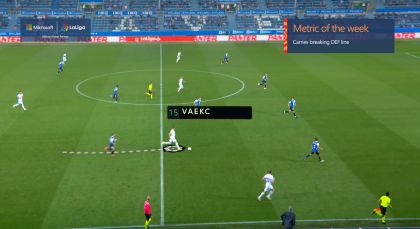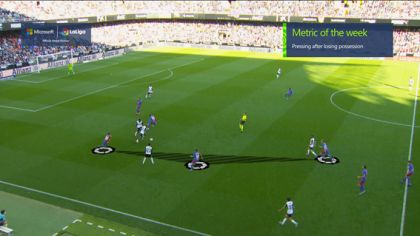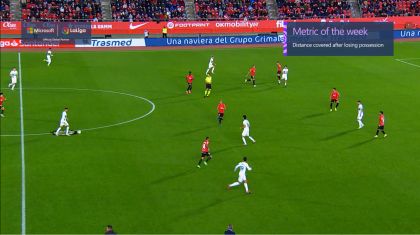LALIGA INSTITUTIONAL
Transparency
Pressroom
FUNDACIÓN LALIGA
Sponsors
Audiovisual rights
LALIGA Business school
Work with us
LALIGA WITH SPORT
Aficiones Unidas
LALIGA FC FUTURES
LALIGA Grassroots
Quality recoveries & build-up play that offers guarantees
This video illustrates how recoveries can be distinguished not only in terms of their effectiveness, but also their quality. Barcelona record the fourth-most advantageous recoveries in the league, i.e. situations that involve a numerical advantage and where the side in possession has more players ahead of the ball than the opposition.
Given the importance of build-up play in the system deployed by Xavi’s troops, the team’s set-up at the start of the attacking transition is key. This video shows how the Barcelona players react in these situations. It’s worth pointing out that 15% of the Catalan giants’ recoveries put them at an advantage.
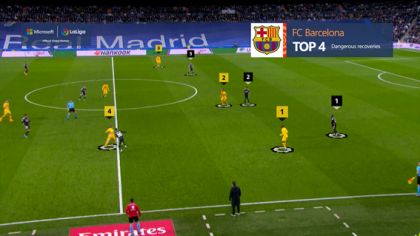
Madrid aim to advance up the pitch & prove their potency
Real Madrid are the LaLiga Santander front runners for the number of carries leading to shots, with four per game to their name. Carries can be analysed from a whole host of angles, but in this case we’re keen to look at their outcome, i.e. shots.
There’s no question that Ancelotti’s charges are capable of making the most of these actions, as illustrated in our Clip of the Week. The players’ ability to go past their man, their skill level and decision-making ability are key to the success of such actions, which can reap rich rewards for the capital club.
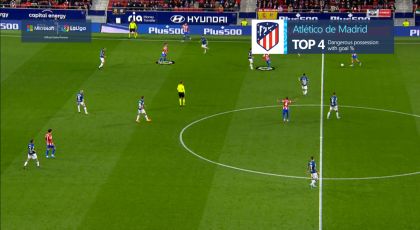
Atletico Madrid & their carries leading to shots
As we can see in this clip, Simeone’s boys post an average of two carries that lead to shots per game. Indeed, this is one of Atleti’s favourite tactics to pose a threat on goal. If we dive deeper and take a look at what the Wanda Metropolitano-based outfit do in possession, we learn that they feature amongst the league’s top five teams for the number of players per possession (almost three), whilst they find themselves amongst the division’s leading five teams for the number of dangerous possessions per match (4.6).

Betis & their breathtaking dangerous possessions
When it comes to possession, there are a whole host of aspects that we can analyse, with one of them being the degree of danger created. When we speak of dangerous possessions, we’re referring to those that end in a goal or a goalscoring opportunity. This video features a dangerous possession put together by Manuel Pellegrini’s charges. Betis excel in this department and lie second in the LaLiga standings for the number of dangerous possessions (5.7 per outing).

Dangerous possessions that result in goalscoring chances
The Real Madrid players ensure that their team balance enables them to consistently produce and improve on their statistics as the games goes on. As we can see in the latest instalment of Clip of the Week, the Blancos record more dangerous possessions than any other side in the league (6.76 per game) and, crucially, they make them count.
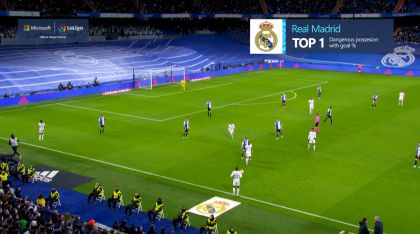
It’s your Game
Matchday 30
Valencia CF
Cádiz CF
SUN 03.04.2022
16:30
Season 2021/2022
Camp de Mestalla
FC Barcelona
Sevilla FC
SUN 03.04.2022
19:00
Season 2021/2022
Spotify Camp Nou
FC Barcelona
Sevilla FC
SUN 03.04.2022
19:00
Season 2021/2022
Matchday 30
Spotify Camp Nou
Barcelona focus on regaining possession in dangerous areas
This clip highlights the importance that advantageous recoveries, i.e. those that involve a numerical advantage, play in the system adopted by Xavi’s men. Indeed, 15% of Barcelona’s recoveries occur in advantageous areas, a return that places them fourth in the league standings in this department.
To gain a greater understanding of Barcelona’s blueprint and focus on the start of their defensive transitions, we note that Xavi’s side occupy the final place on the league podium for the number of players involved in the press immediately after possession is relinquished (3.17 players), whilst the Catalans rank as runners-up in the league table for the distance covered after losing the ball (an average of 15m).
In addition to the percentage of advantageous recoveries highlighted above, Barça lead the way in the top-flight charts for the average height up the pitch at which possession is recovered (40.14m on average), whilst they are top of the class for the number of recoveries in the opposition’s half (over 20 per game).
Sevilla’s impressive width & how it compares to Xavi’s Barça
As we can see from this clip, one of Sevilla’s strengths is their positioning, with the Andalusians boasting the widest team spacing when in possession, with an average of 1,129m2. Meanwhile, their opponents in this intriguing battle occupy fifth possession in this facet with a score of 1,045m2.
A comparison between the Nervion-based outfit and their opponents in the forthcoming round of games makes for interesting reading, given that the two teams occupy similar positions in the rankings when it comes to qualitative and quantitative aspects of their build-up play. Alongside Real Madrid, the pair bag spots on the podium for the number of players involved per possession. Whilst the Catalan giants sit in second with 3.55 players per possession, Sevilla lie hot on their heels in third position with 3.26. The two teams are also evenly matched in terms of the number of passes per possession, with Barcelona’s possessions featuring 6.3 passes to Sevilla’s 5.7.
It is also worth taking a look at the key elements in these two heavyweights’ defensive transitions. During this phase of the game, they occupy the top two spots in LaLiga Santander for recovery rate, i.e. the number of recoveries per minute. In sum, the key to success is in achieving a balance between build-up play and using all of your quality to prevent the opposition from posing a threat on goal.
PLAYER FOCUS
Kounde is stellar top-10 performer
Jules Kounde is a vital cog in Sevilla’s system. Not only is the French stopper a strong all-round performer, he’s also effective and brings a real intensity to everything he does. We’re going to take a look at various aspects of his playing style and, as you may well have guessed from the title, he features amongst the league’s top 10 players in all of the areas we’re going to explore. The commanding centre-back takes his place amongst the top 10 in: carries that break the opposition’s midfield line, which are key to Sevilla’s tactic of playing the ball out of the back; recoveries, racking up more than eight per outing; and in the first passes following a turnover. These latest areas are also important to a team’s system and the initial elements of their build-up play.
However, Kounde’s contribution goes much further and extends to his involvement in the play, as he chalks up an average of 71 passes per game.


